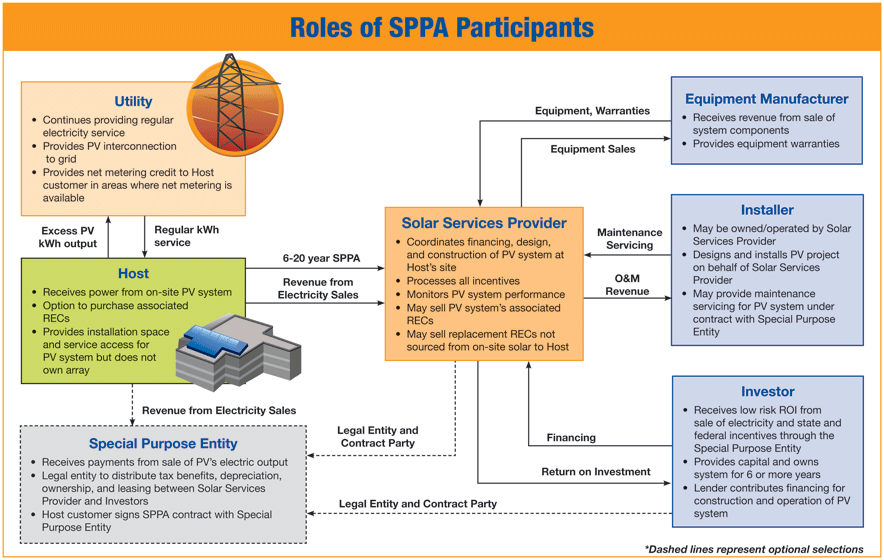What is a Solar PPA?
A Solar Power Purchase Agreement (SPPA) is a financial arrangement in which a third-party developer owns, operates, and maintains the photovoltaic (PV) system, and a host customer agrees to site the system on its property and purchases the system's electric output from the solar services provider for a predetermined period. This financial arrangement allows the host customer to receive stable and often low-cost electricity, while the solar services provider or another party acquires valuable financial benefits, such as tax credits and income generated from the sale of electricity.
With this business model, the host customer buys the services produced by the PV system rather than the PV system itself. This framework is referred to as the "solar services" model, and the developers who offer SPPAs are known as solar services providers. SPPA arrangements enable the host customer to avoid many of the traditional barriers to the installation of on-site solar systems: high upfront capital costs, system performance risk, and complex design and permitting processes. In addition, SPPA arrangements can be cash flow positive for the host customer from the day the system is commissioned.
In summary, A Solar Power Purchase Agreement (PPA) is a financial agreement in which a third-party developer owns, manages, and maintains a solar energy system on a customer’s property. The consumer agrees to pay a fixed rate for the power produced by the system for a certain length of time, generally between 10 and 25 years, that is lower than the rates charged by local utility companies.

A host customer agrees to have solar panels installed on its property, typically its roof, and signs a long-term contract with the solar services provider to purchase the generated power. The host property can be either owned or leased (note that for leased properties, solar financing works best for customers that have a long-term lease). The purchase price of the generated electricity is typically at, or slightly below, the retail electric rate the host customer would pay its utility service provider. SPPA rates can be fixed, but they often contain an annual price escalator in the range of 1 to 5 percent to account for system efficiency decreases as the system ages; inflation-related cost increases for system operation, monitoring, and maintenance; and anticipated increases in the price of grid-delivered electricity. An SPPA is a performance-based arrangement in which the host customer pays only for what the system produces. The term length of most SPPAs can range from six years (i.e., the time by which available tax benefits are fully realized) to as long as 25 years.
The solar services provider functions as the project coordinator, arranging the financing, design, permitting, and construction of the system. The solar services provider purchases the solar panels for the project from a PV manufacturer, who provides warranties for system equipment.
The installer will design the system, specify the appropriate system components, and may perform the follow-up maintenance over the life of the PV system. To install the system, the solar services provider might use an in-house team of installers or have a contractual relationship with an independent installer. Once the SPPA contract is signed, a typical installation can usually be completed in three to six months.
An investor provides equity financing and receives the federal and state tax benefits for which the system is eligible. Under certain circumstances, the investor and the solar services provider may together form a special purpose entity for the project to function as the legal entity that receives and distributes to the investor payments from tax benefits and the sale of the system’s output.
The utility serving the host customer provides an interconnection from the PV system to the grid, and continues its electric service with the host customer to cover the periods during which the system is producing less than the site's electric demand. Certain states have net metering requirements in place that provide a method of crediting customers who produce electricity on-site in excess of their own electricity consumption. In most states, the utility will credit excess electricity generated from the PV system, although the compensation varies significantly depending on state polices.
The Solar PPA provides an economical and hassle-free alternative for companies, factories, and commercial facilities to shift to renewable energy without incurring the initial expenditures of installing a solar system. It also enables customers to save money on their power bills right now while also protecting themselves from potential energy price spikes.
There are no comments for now.